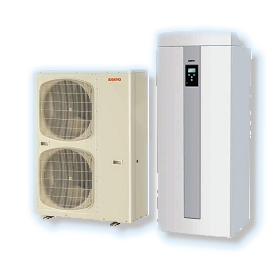Introduction
Heat pumps are becoming an increasingly popular method by which people supply their homes or businesses with hot water and space heating. Increased public awareness about the need for renewable energy and a reduction in carbon heavy forms of energy production has increased the interest in micro-generation schemes. Soaring fossil fuel prices, government funding and money-back schemes have also encouraged the general public to take an interest in adopting alternative and greener technologies to supply their energy needs.

Heat pumps are not considered by some people to be a source of renewable energy as they require an electrical input to operate. Heat pumps become however more renewable as more and more renewable technologies supply the grid with electricity. But the real asset of heat pumps is also that with 1kW of electricity the system will return 2kW or 3kW of heat in function of the coefficient of performance (COP). The energy is taken from the air surrounding the building and the environmental impact of this technology is mainly limited to the electricity used for its operation.
In this introduction, heat pumps in general and the processes involved will be briefly explained. The history of heat pumps for heating shall also be explored. Heat pumps are used to remove heat from one location or heat source and supply it to another usually known as a heat sink. It can be used to provide heating or cooling.
With the increased interest in heat pumps in commercial and residential locations more companies are seeing the value of investing part of their money and business in the technology. This in turn creates a level of competition between heat pump designers and installers to produce more and more effective heat pumps with regards to performance and environmental impact. One of these advances in the technology has been the use of natural refrigerants and in particular importance to this project the use of CO2.
At the moment CO2 heat pumps are not performing as predicted in the UK. This could be down to a number of factors which combine with a lack of understanding of the technology. This project looks to assess the potential for CO2 heat pumps in the UK.

Bibliography
Wind turbine jpeg - http://www.tonybaldry.co.uk/wp-content/uploads/2010/08/Wind-Turbines.jpg
Tidal turbine jpeg - http://www.treehugger.com/files/2007/06/12_megawatts_wo.php
PV panels jpeg - http://www.horizonrenewables.co.uk/solar-photovoltaics/photovoltaic-panels-roof-mounted.html
Heat pump jpg -http://www.buildingdesign-news.co.uk/2010/43-Sanyo-Split-systems-Air-conditioning-Heat-pumps-Inverter-systems-News-291010.asp















